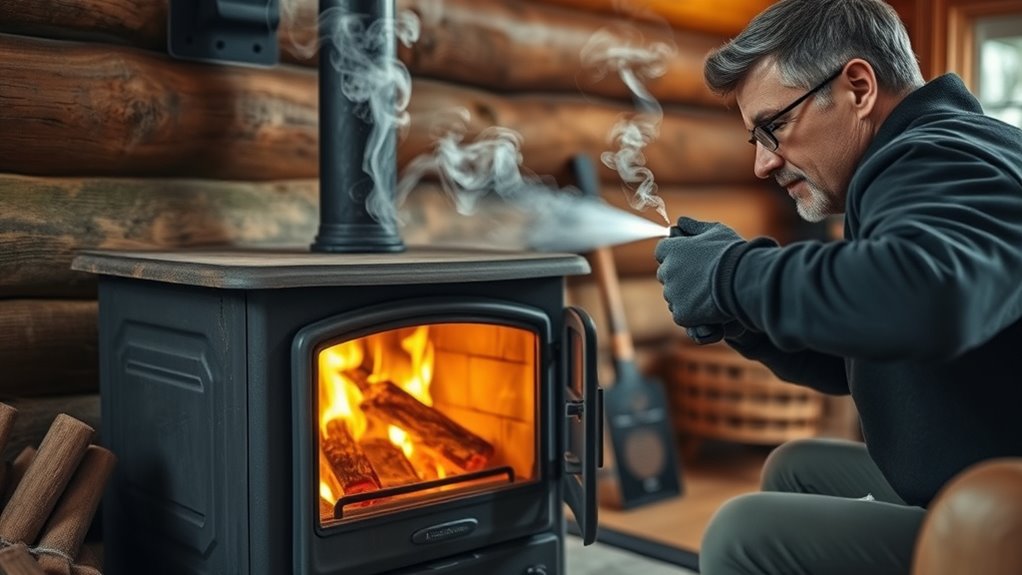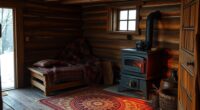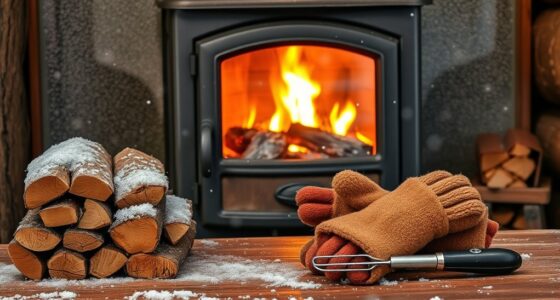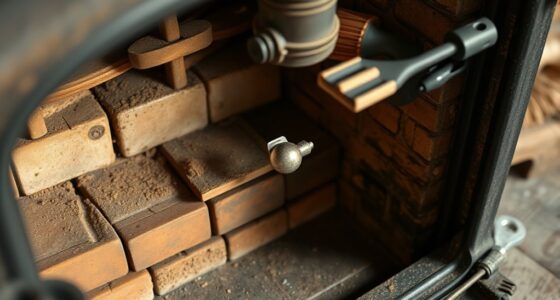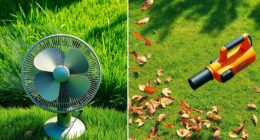To solve wood stove draft problems and smoke leaks, start by inspecting and cleaning your chimney and vents to remove obstructions like creosote or debris. guarantee your stove is properly placed with enough clearance and consider adjusting the damper and air vents for better airflow. External factors like wind or weather can also impact draft, so installing a chimney cap or wind shield might help. If issues persist, seeking professional advice ensures safety and efficiency. Keep exploring for more effective solutions.
Key Takeaways
- Regularly inspect and clean the chimney cap, flues, and vent pipes to remove obstructions and creosote buildup.
- Ensure proper stove placement with adequate clearances from walls and furniture to promote effective draft.
- Adjust damper and air vents gradually to optimize airflow and improve combustion efficiency.
- Install chimney caps or wind shields to mitigate external wind effects that disrupt draft.
- Seek professional help if persistent smoke leakage or draft issues occur despite troubleshooting efforts.
Understanding How Draft Works in Your Wood Stove

Understanding how draft works in your wood stove is essential for ensuring efficient burning and safe operation. Draft refers to the airflow dynamics that draw air into the stove and vent smoke outside. When the draft is strong, it promotes proper combustion efficiency by providing enough oxygen for the fire to burn cleanly. Conversely, weak or inconsistent draft can cause smoke to back up into your home and decrease heat output. Factors like chimney height, obstructions, and outside temperature influence draft performance. Knowing how these elements interact helps you optimize airflow, ensuring your stove burns hotter and cleaner. By managing draft effectively, you improve combustion efficiency and reduce smoke leakage risks, making your stove safer and more effective.
Common Signs of Draft Issues and Smoke Leakage
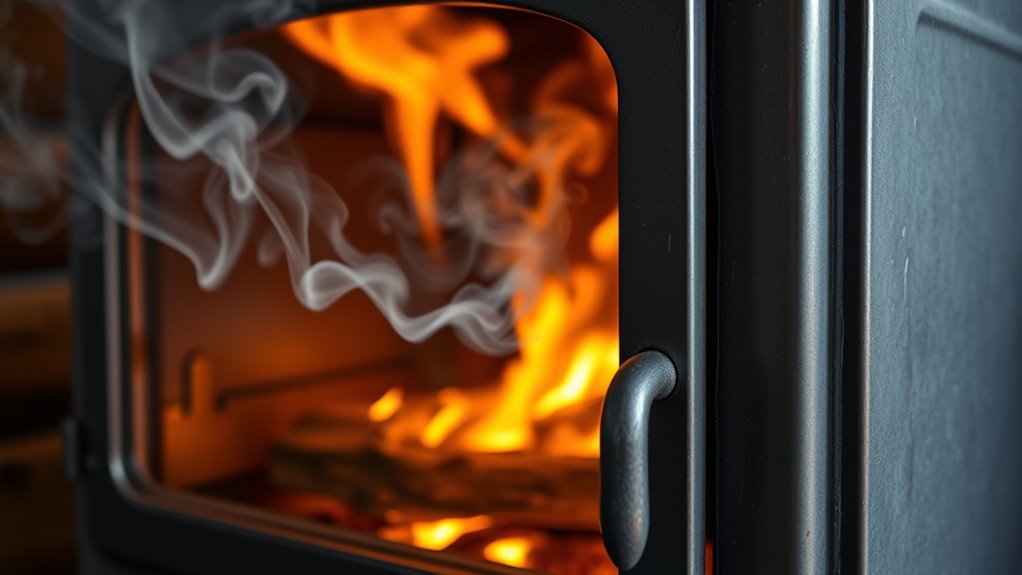
If your wood stove isn’t drawing properly, you’ll notice certain signs that indicate draft problems and smoke leakage. First, you might see smoke escaping from the stove or around the door, which suggests inadequate draft and can impact your indoor air quality. Second, you could observe smoke filling the room instead of venting through the fireplace chimneys, creating a safety hazard. Third, you may experience a persistent, strong odor of smoke or burning wood that lingers indoors. These signs point to draft issues that prevent proper airflow and cause smoke to leak into your living space. Recognizing these indicators early helps you address ventilation problems, maintain safe indoor conditions, and ensure your fireplace chimneys work efficiently. Vetted solutions and proper maintenance can help resolve these issues effectively. Additionally, inspecting and cleaning your chimney and flue regularly ensures optimal draft performance, reducing the likelihood of smoke leakage. Regularly checking for blockages and ensuring proper chimney height can further improve draft efficiency and prevent smoke from escaping into your home. Improving your understanding of cost behavior analysis can also assist in maintaining the overall efficiency of your heating system and prevent costly repairs. Maintaining awareness of automation technologies can also assist in modernizing your heating system for better control and safety.
Inspecting and Cleaning Your Stove’s Chimney and Flue
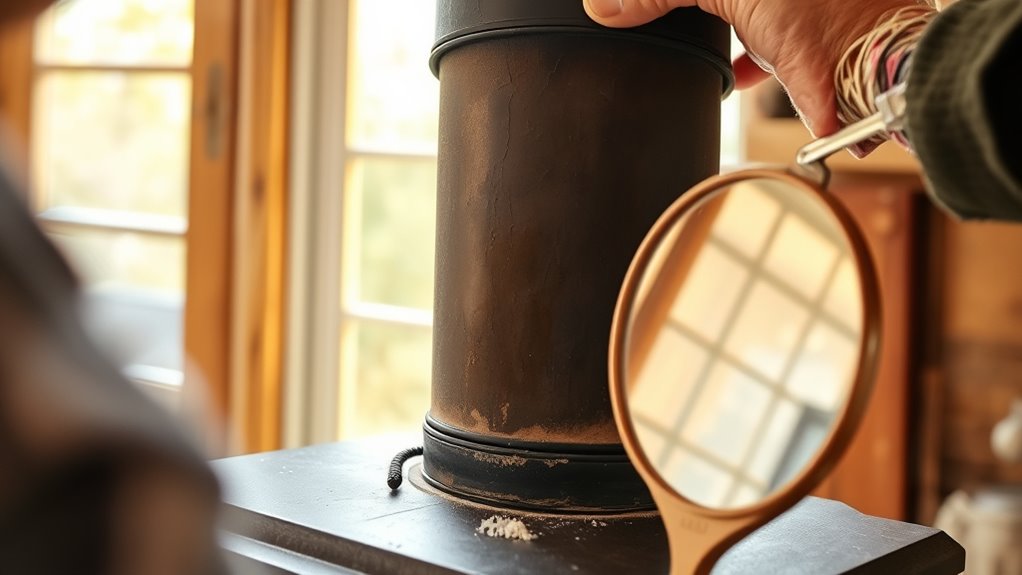
Regularly inspecting and cleaning your stove’s chimney and flue is essential to maintaining proper draft and preventing smoke leaks. Start by checking the chimney cap; a damaged or clogged cap can let debris and animals enter, disrupting airflow. Look for creosote buildup, which appears as a sticky, tar-like residue, and remove it using a chimney brush. Creosote is highly flammable and can cause chimney fires if left unchecked. Ensure the flue is clear of obstructions and soot deposits that hinder proper draft. Regular cleaning not only improves efficiency but also reduces fire risk. Use safety gear and follow manufacturer instructions. Keeping your chimney and flue clean guarantees safe operation and helps eliminate smoke leakage issues. Additionally, proper ventilation can improve airflow and prevent dangerous smoke buildup inside your home. Proper airflow is also influenced by the design of your chimney system, which should be assessed and maintained accordingly. For optimal performance, consider inspecting your electric bike generator or other energy sources to ensure they are functioning efficiently, as power issues can sometimes contribute to draft problems. Being aware of airflow dynamics can help you identify underlying issues affecting your stove’s performance.
Checking for Obstructions and Blockages in Venting Systems
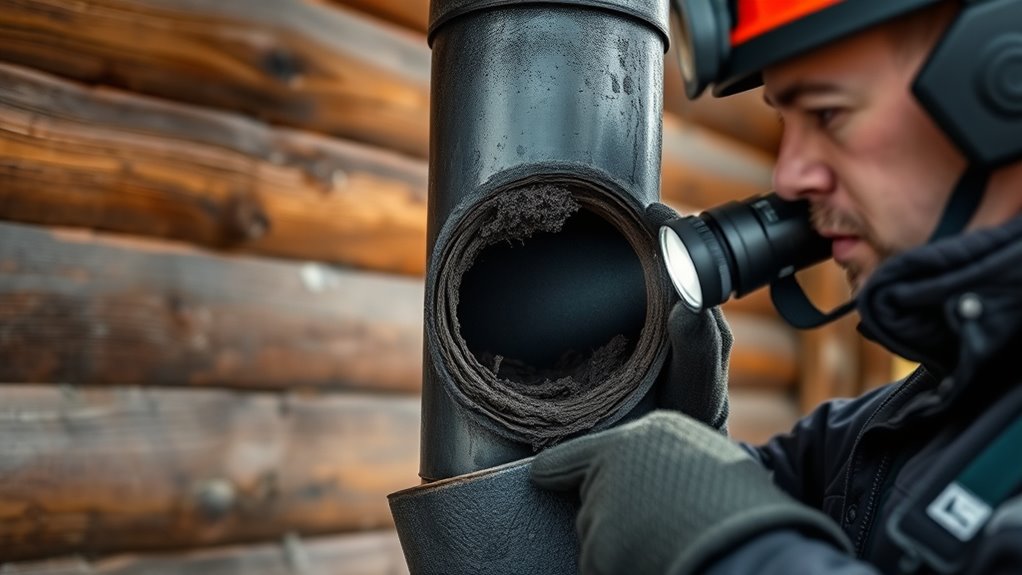
Before operating your stove, you should check for any obstructions or blockages in the venting system that could hinder proper draft. Start by inspecting the vent pipe for debris, nests, or soot buildup that may restrict airflow. Next, examine the chimney cap to ensure it’s not clogged with leaves, bird nests, or debris, which can trap smoke and reduce draft efficiency. Finally, look for any visible obstructions inside the chimney that could cause smoke to leak back into the room. Clear out any blockages you find, and make sure the vent pipe and chimney cap are free of debris. Properly maintained venting ensures safe operation and a strong draft, preventing smoke leakage and improving your stove’s performance. Additionally, regularly inspecting the venting system can help identify potential issues early and maintain optimal draft conditions. Regular maintenance also minimizes the risk of smoke leakage, ensuring safer and more efficient stove operation. Incorporating proper maintenance practices can further prolong the lifespan of your stove and its components.
Ensuring Proper Stove Placement and Clearances
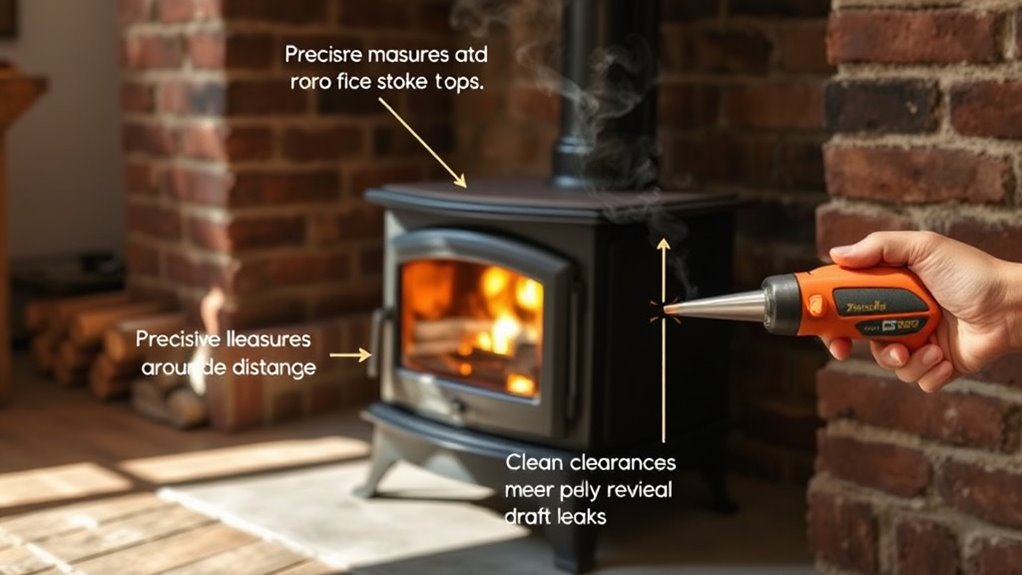
To guarantee your wood stove operates safely and efficiently, you need to pay close attention to proper clearance and placement. Choosing the right spot can prevent draft problems and reduce fire hazards. Make sure you’re aware of recommended distances from walls and other combustible materials to optimize performance. Proper self watering plant pots placement can also influence airflow and draft issues around your stove. Remember, attention in placement plays a vital role in fostering safe and effective creative problem-solving when setting up your stove. Additionally, understanding dog names can be a fun way to personalize your space, especially if you have a furry companion around during your stove setup process. Incorporating AI-powered detection methods can further assist in identifying potential safety hazards or inefficiencies related to stove placement. Employing draft prevention techniques can also help maintain optimal airflow and safety standards around your wood stove.
Proper Clearance and Distance
Ensuring proper clearance and distance when installing your wood stove is crucial for safety and efficient operation. Following clearance guidelines helps prevent fire hazards and guarantees proper draft. Think of it as creating a safe buffer zone around your stove:
- Maintain at least 36 inches of space in front for safe fireplace placement and access.
- Keep side clearances of a minimum of 18 inches from combustible materials.
- Ensure the stove is positioned away from walls or furniture to promote proper airflow and draft.
- Regularly check for compliance with safety standards to ensure installation remains safe and effective. Proper clearances also help reduce smoke leakage problems and improve combustion efficiency.
- Proper placement also minimizes the risk of airflow disruptions, which can negatively impact stove performance and safety. Utilizing stove placement techniques can further enhance safety and efficiency.
- Using appropriate wall protection materials can prevent heat transfer and potential damage.
These steps reduce smoke leakage issues and improve combustion. Adhering to clearance guidelines not only safeguards your home but also guarantees your stove functions at its best. Proper placement is the foundation for a safe, efficient, and trouble-free wood stove experience.
Choosing Optimal Stove Position
Choosing the right spot for your wood stove is essential to guarantee safety, proper draft, and efficient heating. Proper vent placement is key; position the stove where venting can be optimized for good airflow and minimal smoke leakage. Avoid placing the stove too close to walls or furniture, which can obstruct room airflow and cause draft issues. Ensure there’s enough clearance around the stove for heat circulation and safe operation. Consider the room’s layout to promote even heat distribution and reduce smoke leakage. A well-placed stove improves draft and prevents smoke from entering the room. Additionally, ventilation airflow is crucial for maintaining proper draft and ensuring smoke exits efficiently. Proper stove clearance and placement also help prevent heat buildup and potential safety hazards. By carefully selecting the location, you’ll enhance safety, maximize heating efficiency, and reduce potential smoke problems caused by poor vent placement or airflow obstructions. Ensuring adequate air circulation throughout the room supports optimal draft and safe operation. Properly managing cost and budgeting considerations, such as choosing affordable materials and efficient design options, can also contribute to a safer and more effective setup. Furthermore, understanding and implementing draft control measures can significantly improve the overall performance of your stove system.
Adjusting Air Vents and Damper Settings for Optimal Draft
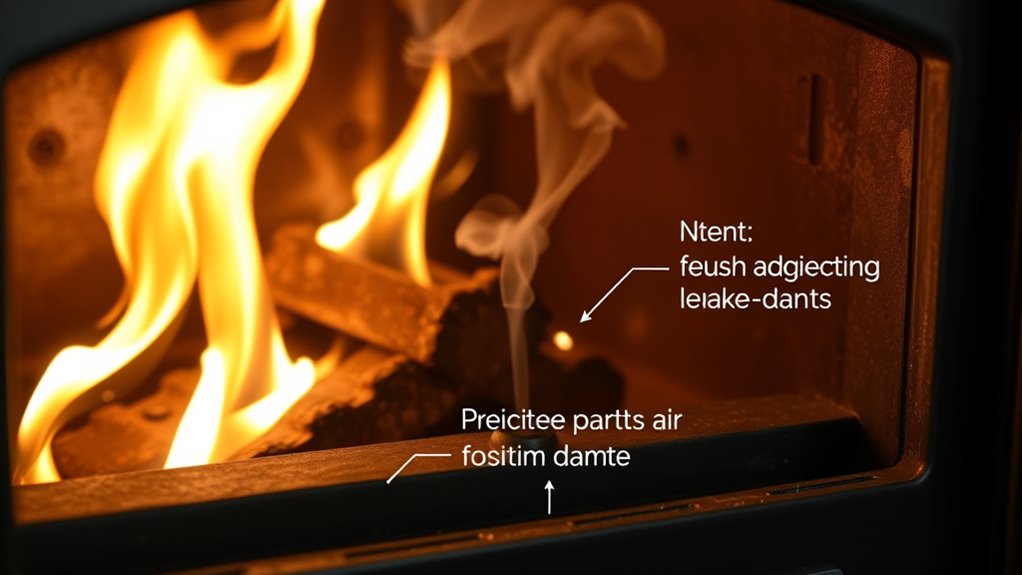
Adjusting your air vents and damper settings is essential for achieving the right draft in your wood stove. Proper air vent calibration guarantees your stove gets enough oxygen for efficient burning without smoke leakage. Damper adjustment controls airflow, helping you fine-tune the draft. To optimize performance:
- Open or close the air vent gradually to find the balance where the fire burns steadily without excessive smoke.
- Adjust the damper to control airflow, ensuring the fire gets enough oxygen but not so much that smoke escapes.
- Test the draft by observing the smoke flow; it should rise straight up without escaping around the door or stovetop.
Making these adjustments allows you to control the draft effectively, preventing smoke leakage and improving heat output.
Troubleshooting External Factors Affecting Draft Performance
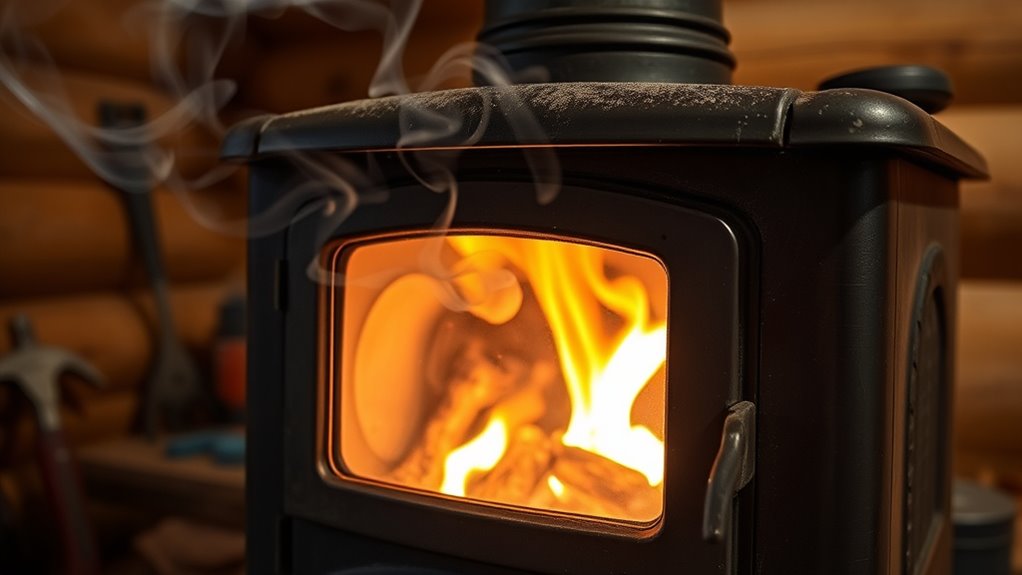
External factors can profoundly impact your wood stove’s draft, often causing it to fluctuate or weaken despite proper internal adjustments. One major influence is outdoor wind, which can either boost or disrupt the airflow through your chimney. Wind blowing directly against the chimney can create negative pressure, pulling smoke back into your home or reducing the draft’s strength. Surrounding trees also play a role; tall trees can shelter your chimney from wind or, conversely, funnel gusts that interfere with proper draft. Changes in weather, like storms or high-pressure systems, can further affect performance. To troubleshoot, observe how these external conditions align with draft issues, and consider installing a chimney cap or wind shield to minimize wind’s impact and stabilize your stove’s draft.
When to Seek Professional Assistance for Draft Problems
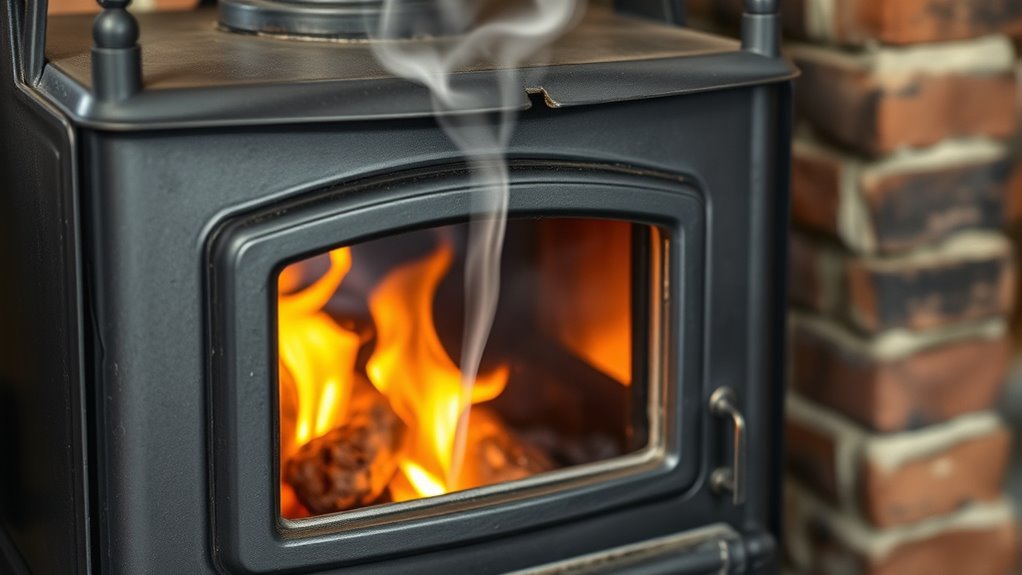
While minor draft issues can often be resolved through simple troubleshooting, persistent or severe problems indicate it’s time to call in a professional. If you notice smoke spilling into the room despite basic fixes, it’s a sign you need expert help. Consider consulting a professional if:
- Your stove consistently produces smoke despite proper operation.
- You suspect chimney damage or blockages that simple cleaning can’t fix.
- You experience ongoing draft fluctuations or unsafe smoke leakage.
A professional inspection can identify underlying issues like chimney repair needs or venting obstructions. They can also perform a thorough assessment of your chimney system’s integrity, ensuring your stove operates safely and efficiently. Don’t delay seeking expert help if problems persist beyond basic troubleshooting.
Frequently Asked Questions
How Does Outdoor Weather Impact My Wood Stove’S Draft?
Outdoor weather has a big impact on your wood stove’s draft. When outdoor temperature drops, the air becomes denser, which can improve draft and help smoke escape. However, wind effects can disrupt airflow, causing smoke to leak or back up into your home. Strong gusts push air into the chimney, reducing draft efficiency. You might notice more trouble with draft during windy, cold days, making it harder to keep a steady, clean burn.
Can Type of Fuel Affect Draft Efficiency and Smoke Control?
Imagine your stove as a dance partner, and fuel type as its rhythm. Different fuels, like hardwood or softwood, affect draft efficiency and smoke control, much like a dance tempo influences movement. Hardwood burns cleaner and hotter, improving draft, while softwood creates more smoke and less consistent draft. Choosing the right fuel type helps your stove perform smoothly, minimizing smoke leakage and optimizing heat output.
What Safety Precautions Should I Take During Chimney Inspections?
When performing chimney inspections, prioritize chimney safety by wearing gloves, goggles, and a dust mask. Use proper inspection tools like a flashlight, mirror, and brush to thoroughly check for blockages, cracks, or creosote buildup. Confirm the area is well-ventilated and keep a fire extinguisher nearby. Always follow safety guidelines, and if you’re unsure, consider hiring a professional to avoid potential hazards and ensure your chimney functions safely.
How Often Should I Schedule Professional Chimney Cleanings?
You should schedule professional chimney cleanings at least once a year to guarantee proper chimney maintenance, especially if you use your wood stove regularly. Regular cleanings help prevent creosote buildup, reducing fire risk and improving draft. If you’ve recently upgraded your stove or notice smoke leakage issues, more frequent inspections might be necessary. Staying on top of chimney maintenance keeps your system safe and efficient, protecting your home and enhancing your stove’s performance.
Are There Specific Stove Models Better Suited for Poor Draft Conditions?
Imagine a cozy fire flickering perfectly in your stove, even on tricky days with poor draft. Some stove models are designed for better draft compatibility, making them ideal if your chimney struggles to draw properly. Look for models with enhanced airflow features or adjustable dampers. You’ll find these options help maintain a steady burn, reduce smoke leakage, and keep your home warm and safe, no matter your chimney’s draft challenges.
Conclusion
Remember, a well-functioning wood stove is like a trusted friend—reliable and warm. Don’t let stubborn draft problems dampen your cozy moments; instead, see them as a gentle nudge to uncover hidden issues. With patience and the right steps, you’ll restore your stove’s performance and keep smoke where it belongs—outside. So, embrace the challenge, and turn those smoky troubles into a clear path to comfort and warmth.

